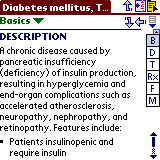PDA Use Can Prevent More Than $100 Million in Medical Errors
Skyscape reports:
HUDSON, Mass. - December 15, 2003 - More than half the doctors in the United States use PDAs, and among residents and students the percentage is even greater therefore it is essential to understand how physicians can best use this technology to maximize their effectiveness. A new survey, released today, shows significant results about doctors’ increasing reliance on their PDAs and their impact on daily activities. More than 85 percent of the survey respondents pointed to PDAs as helping to reduce the number of medical errors, with more than 50 percent of doctors indicating PDA use reduces their medical errors by more than 4-5 percent. With the National Academy of Science – Institute of Medicine reporting that medical errors cost the healthcare system $2 billion a year, this equates to preventing more than $100 million in preventable drug errors alone. Yet less than 20 percent of medical professionals have their PDA software integrated with the larger hospital IT enterprise, signifying an area where there is still room for significant growth.
·The survey of more than 900 doctors who use handheld computers was conducted by Skyscape®, Inc. (www.skyscape.com), a leading provider of
enterprise-wide mobile medical and nursing reference solutions. Skyscape has researched PDA effectiveness for medical professionals for almost a decadebeginning with a landmark Constellation Project involving a study of Apple’s Newton platform with Brigham & Women’s Hospital, Harvard
Medical School and Massachusetts General Hospital.
“The survey results reinforced what we knew of the benefits PDAs bring medical professionals, but the impact PDAs have when it comes to reducing
medical errors, and improving efficiencies, exceeded our expectations,” said RJ Mathew, vice president, marketing and business development for
Skyscape. “The survey clearly shows physicians have moved into a mainstream reliance on PDAs and medical software for PDAs. The results show that just like the stethoscope, the PDA is increasingly becoming an integral tool in doctors' daily practice and by integrating medical references we can enable doctors and their enterprises to realize even greater benefits.”
Respondents to the Skyscape survey stated that PDA use provides significant benefits by enabling them to spend more time with patients, while still treating more each day, and by improving the overall quality of patient care. Specific results include:
* More than 88 percent of doctors use their PDAs at least four times a day, with 15 percent using their PDAs more than 25 times a day.
* When asked how they use their PDAs, 72 percent of doctors reported they rely on their PDA for treatment purposesprimarily using it for
drug references, clinical references, drug interaction guides or hospital treatment guidelines.
* Almost 90 percent of the doctors concluded that PDAs help them provide better care.
* Over 85 percent of physician respondents agreed that by using a PDA they had decreased the number of potential medical errors. And more
than 50 percent communicated that by using a PDA they were able to eliminate over 4 percent of medical errors.
* When asked to quantify the specific benefits PDAs bring to their daily practice, almost 20 percent of respondents concluded that PDA use
enables them to treat at least three more patients a day, with another 20 percent of respondents concluding that they can treat 1 – 2 additional
patients per day.
* Doctors do not just rely on one reference for their PDA. More than 70 percent of doctors have at least three medical references on their PDA
and 22 percent have more than eight references.
* Medical software for PDAs is increasingly being integrated with other applications but there is still significant room for growth. In each
case less than ten percent of medical professionals reported their PDA software is integrated with prescription, billing, charge capture or patient
records systems.
Skyscape solutions are increasingly being adopted by leading medical institutions, and today more than 240,000 medical professionals rely on
Skyscape-powered references. Over the next year, medical professionals will further increase their PDA usage, with industry analyst firm Forrester
Research reporting that 90 percent of all health systems are engaged in a handheld project or are considering one.








 Skyscape has also updated their version of
Skyscape has also updated their version of 



